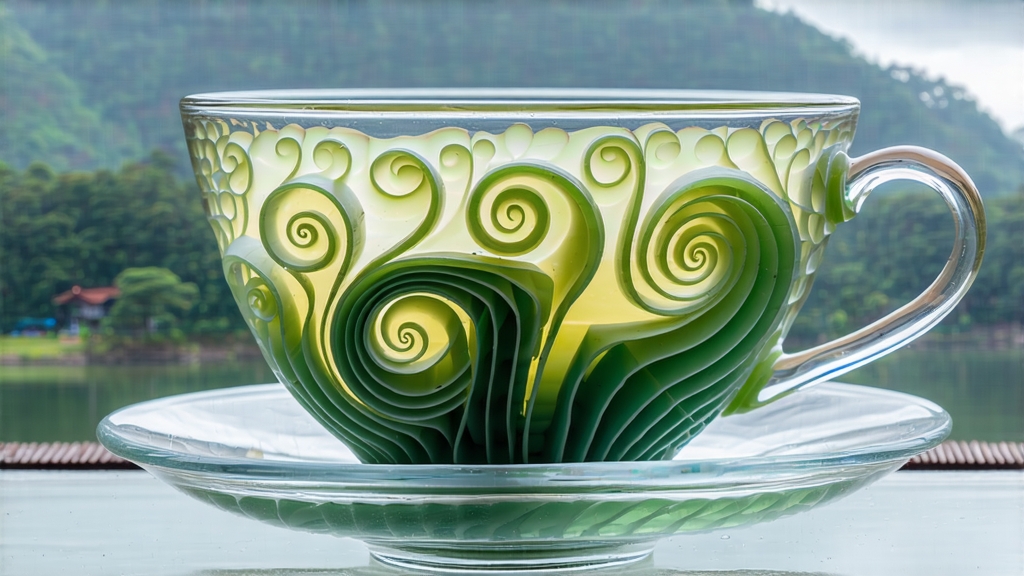
Biluochun, whose name translates literally to “Green Snail Spring,” is one of China’s ten most celebrated teas, yet it remains a delicate secret outside serious tea circles. Grown in the mist-laced microclimate where the Yangtze River meets the vast Taihu Lake in Jiangsu Province, this green tea is distinguished by its tiny, spiral-shaped leaves, white downy tips, and an aroma so fragrant that, according to Qing-dynasty lore, picking monks once tucked fresh leaf inside their robes to perfume the meditation hall.
History
The first written record appears in the Tang Dynasty’s Classic of Tea, but Biluochun’s fame crystallized during the Kangxi reign (1661-1722). The emperor, touring the lake, was served an infusion so aromatic that he asked its name. Told it was “Xia Sha Ren Xiang” (literally “scary fragrance”), he deemed the title inelegant and renamed it Biluochun for its snail-shell curl and spring harvest. Imperial patronage propelled the tea into tribute status; by the late 1800s, Suzhou merchants were exporting it to Russia via the Grand Tea Road.
Terroir & Harvest
Authentic Biluochun comes only from Dongting Mountain, actually two islands—Dongshan and Xishan—within Taihu Lake. The water body moderates temperature, creating nightly mists that diffuse sunlight and coax slow, tender growth. Soils are acidic, quartz-rich, and laced with crushed shell deposits, imparting a subtle minerality. Tea gardens are interplanted with fruit trees—peach, plum, apricot—whose blossoms add floral volatiles absorbed by the tea buds.
Plucking begins when the meteorological spring starts, usually between the Qingming and Grain Rain solar terms (early April). Only the top bud plus the adjacent unfolding leaf are taken, yielding 60,000 to 80,000 shoots per 500 g of finished tea. Pickers work before 9 a.m., while dew still glistens, and deliver leaf in shallow bamboo baskets to prevent compression.
Crafting the Spiral
Within four hours of plucking, the leaf undergoes a six-step, entirely manual process:
- Withering: Spread 2 cm thick on bamboo trays in shaded draft for 30–40 min, reducing moisture to 68 %.
- Pan-firing (shaqing): A wok heated to 180 °C receives 250 g of leaf; the maker tosses, presses, and rolls for 3–4 min, destroying enzymes that cause oxidation.
- Rolling & curling: Temperature drops to 70 °C; fingers form the “kill-green” leaf into tight spirals against the wok wall, a motion requiring wrist agility honed over years.
- Re-firing: At 60 °C, the spiral is further dehydrated while aroma concentrates; the tea is now called maocha.
- Selection: Masters pick out broken bits and grade by size and downiness.
- Final baking: A gentle 50 °C for 20 min sets the moisture at 5–6 %, locking in fragrance and shelf life.
The result is a tea that looks almost black when dry yet flashes jade-green once wet, each curl no larger than a garden pea and coated in silvery trichomes.
Varieties
Although “Biluochun” is a protected geographical indication, the market recognizes three quality tiers:
- Supreme Original: picked before Qingming from heirloom fruit-tree gardens; 1 kg needs 140,000 buds.
- First Grade: harvested in the Grain Rain window; slightly larger leaf, yet still intensely aromatic.
- Everyday Biluochun: machine-assisted, grown on terraced lakeside farms; affordable but lacks the signature fruity nuance.
Brewing Ritual
To unlock the spring spiral without scalding its delicacy, use a tall glass or gaiwan:
- Pre-warm vessel with 80 °C water.
- Measure 3 g for 150 ml.
- Fill to one-third capacity, gently swirling to coat leaves; inhale—the first aroma is peach blossom.
- Top up to full volume after 30 s; steep 60 s.
- Subsequent infusions: add 15 s each time; good for six brews.
Watch the curls unfurl like miniature ferns, a performance Chinese drinkers call “the dancer awakens.”
Tasting Notes
Aroma: top notes of lychee